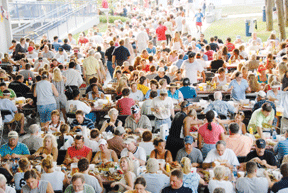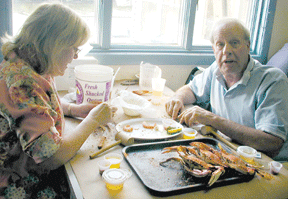
Volume XVII, Issue 32 # August 6 - August 12, 2009 |
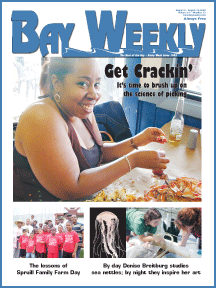 |
Pickin’ a Feast
|
|
It’s Rotary Crab Feast this week, time to brush up on the science of crackin’
by Margaret Tearman
It is late summer and Chesapeake Country is deep into crab season, a season we celebrate with an Annapolis tradition — the 64th Annual Rotary Crab Feast.
Billed as the world’s largest crab feast, the event is one of frenzied feeding as 3,000 people gather at Navy-Marine Corps Memorial Stadium to dig into more than 475 bushels of steaming crustaceans.
It is here that digging in takes on its own meaning because if there is one thing Marylanders are proprietary about, it’s their crabs: How to catch them, how to cook them and, oh so important, how to eat them.
Everyone agrees on the basic, time-tested tools for the job: newspaper, a wooden mallet, a knife, Old Bay seasoning, vinegar — and lots of paper towels. These are necessities. Then there are renegades, those who dip their crab into melted butter or cocktail sauce.
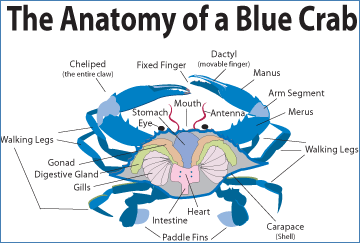
![]() Now about eating the crabs. Please note: Eating is properly referred to as picking. You’ve got to know the language as well as show the skill.
Now about eating the crabs. Please note: Eating is properly referred to as picking. You’ve got to know the language as well as show the skill.
Ask almost any Marylander how to pick a crab, and you will get a detailed tutorial. The methods vary, but opinions do not. Everyone believes their way is the best way to pick crab. Picking methods are passed down through generations. Newcomers eager to learn the art find plenty of willing teachers. But be warned: Sitting between two pickers each using their own time-tested methods can get dangerous. Take sides and you may, at best, lose a picking pal. Bruised knuckles a distinct possibility.
In preparation for the big event, Bay Weekly visited a busy crab house to research picking methods. As we expected, no two are alike, and the pickers were all passionate about doing it their way.
Artists at Work
Jeff Ludwig of Dunkirk is precise as a soldier practicing military maneuvers. Methodical is his operative word.
“I split the back, pop it open and set it aside,” he tells Bay Weekly. “I keep the bodies as counters, so I know how many I’ve eaten.” Count is important.
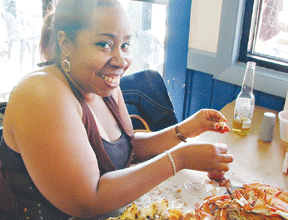 |
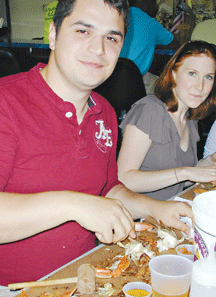 |
Maryland native Crystal Blair, top, won’t share the recipe for her dipping sauce. It’s a family secret.Jeff Ludwig of Dunkirk never varies his picking methods, while New Jerseyite Mary Krawczyk is learning to do it his way, top right.Barry Hurlowitz from Potomac believes the yellow tamale is an aphrodisiac; his friend, JoAnn Hoffman, happily gives him her crab’s share, right. |
|
“I don’t remove the legs. I break the crab in half and start with the backfin, working from one side to another. The legs are good handles for dipping.” Does he ever vary his picking method?
“No m’am,” he responds. “Never.”
One of Ludwig’s dining companions is more about instant gratification. The mallet is Peter Chorbajian’s tool of choice.
“I open them the same way Jeff does, but then we go in different directions,” Chorbajian reports. “I take off the legs and eat them first. And we have this mallet for good reason: to smash the shell.”
To the chagrin of his fellow diners, Chorbajian delivers a mighty whack. The shell splinters, and he happily picks through the debris for each sweet morsel.
Peter’s sister, Jackie is a self-professed “neat freak.” She begins by first removing all of the legs and setting them aside in a neat pile. “Then I crack open the body and really clean it out. I can’t stand all the guts and stuff inside. It is just not attractive,” she says.
When the crab is cleaned to her high standards, Jackie delicately pulls out the backfin, wiping her hands after almost every bite. Neat freak to the end.
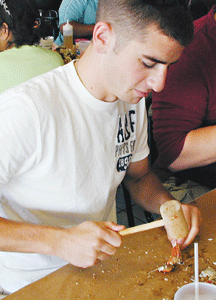 |
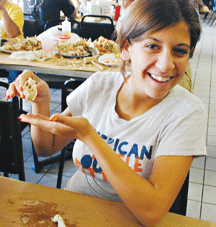
Peter Chorbajian’s favorite tool is the mallet as he goes in for a whack, left.Jackie Chorbajian, above, likes her crabs nice and neat, even if her friends call her “freaky clean.”Jocelin Cole’s mother was her “crab professor,” teaching her to save the claws for dessert, right. |
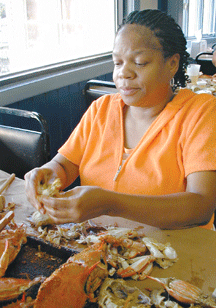 |
Picking Maryland crabs is a highly prized local skill. Newbies to Bay country must learn from the native pros. As Mary Krawczyk, a New Jersey native transplanted to Arlington, can attest. “I just copy him,” she says, pointing to Ludwig.
Other methods are inherited, for some a family tradition. Just ask Suitland natives Crystal Blair and Jocelin Cole.
“We’ve been eating crabs since birth,” says Blair.
“Our mammas taught us how to pick,” Cole says. “My mom was my crab professor.”
The ladies have personalized their similar techniques.
“First I have to feel the weight,” says Blair. “I hold each crab and make sure they’re heavy before I start to pick.”
Once satisfied the crab is worthy of the work, Blair pulls off all the legs, followed by the shell.
“The next thing I do is a little different,” she explains. “I use the claw to clean out the body. I don’t like the lungs and stuff.” The claw-cleaned crab is then broken in half and the meat cleanly picked.
But Blair has a secret: her special sauce. She won’t divulge proportions, only going so far as to say it is a mixture of vinegar, catsup, Old Bay, salt and pepper.
“It is an old family secret.”
Cole picks her crab with a slightly different tact.
“I pull off all the legs,” she says. “But I don’t use the claw to clean it out. I use my long fingernails.” The claws have their purpose in Cole’s picking order. “They are my dessert.”
A spotless eating area is Barry Hurlowitz’s main priority.
“Rule number one,” he says, “is keep the area clean.” Although he finds the mess disdainful, he has a special place in his heart for the mustard, or tamale.
“I love it,” he says. “It is an aphrodisiac.” His date, JoAnn Hoffman, rolls her eyes as she plops a dollop of the yellow goo from her crab on to his. Done, she grabs an ice-cold beer, the best way to wash it all down.
When it comes to picking crabs, there is one undisputed fact: Everybody’s got a different way and everybody’s way is the right way.
Picking for Now and Later
Show off your best method, Friday August 7 from 5-8pm at Navy-Marine Corps Memorial Stadium. You’ll be picking for a good cause. Since the first crab was picked at the Rotary Crab Feast in 1964, this fundraising feast has brought in more than $1 million for area charities and non-profit groups. Last year’s crab feast distributed more than $63,000 to 33 organizations, including Habitat for Humanity, Anne Arundel County Food Bank, Chesapeake Bay Foundation, Hospice of the Chesapeake, Kids and Cops Outreach, YWCA and the Annapolis Chorale.
Rotary Crab Feast: 5-8pm F Aug. 7 (rain or shine; most tables are protected) @ Navy-Marine Corps Memorial Stadium, Annapolis. $60 adults; $30 children: 443-951-0340x100; [email protected]; www.annapolisrotary.com/crabfeast.asp.
The Editor’s SayPicking a crab is like printing a newspaper: There are rules for making a proper job of each, and the editor thinks she sets the rules. First, assemble crab knife, appetizer fork and mallet. A heavy plastic mallet has advantages, but plastic knives are useless. With your knife, remove first the apron, then the top shell. If you’re a mustard eater, your feast begins with dollops in each inner tip of the shell. Returning to crab, cut off face, eyes and lungs. Remove intestines, and remove or enjoy mustard. Next, following the lead of Jeff Ludwig, break the body into symmetrical halves. Use each leg (and both claws) as a lever to remove its attached nugget of meat from the shell. Most profitable is the swimming leg. Bracing the back of the crab with your thumb, insert your index finger like a hook under the carapace where leg meets body. Wiggle and break off a jumbo lollypop of backfin meat. Other legs, if skillfully manipulated, offer smaller chunks. Break each removed leg at its joints and suck out meat. Cross section the body with your knife. Dig out remaining meat with knife tip or fork. Break claws at joints. Position your knife blade crossways across each segment to be cracked. Tap top of blade with mallet to make a clean cut through shell. Pull cracked segment apart to release (ideally) whole leg meat; in a very full crab, however, you’ll need to scrape meat out with your knife. Thanks to Mark Ladley — formerly of North Beach Park, now of Traverse City, Michigan — for teaching me the right way to pick a crab. –Sandra Olivetti Martin |
